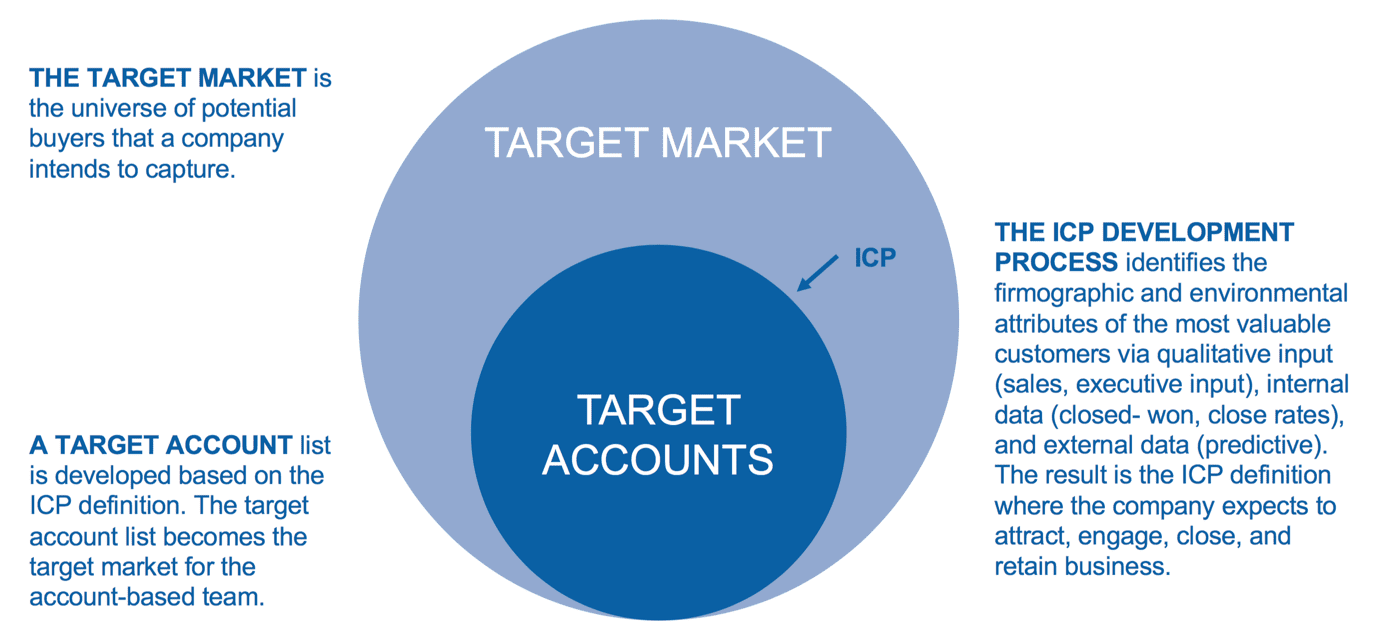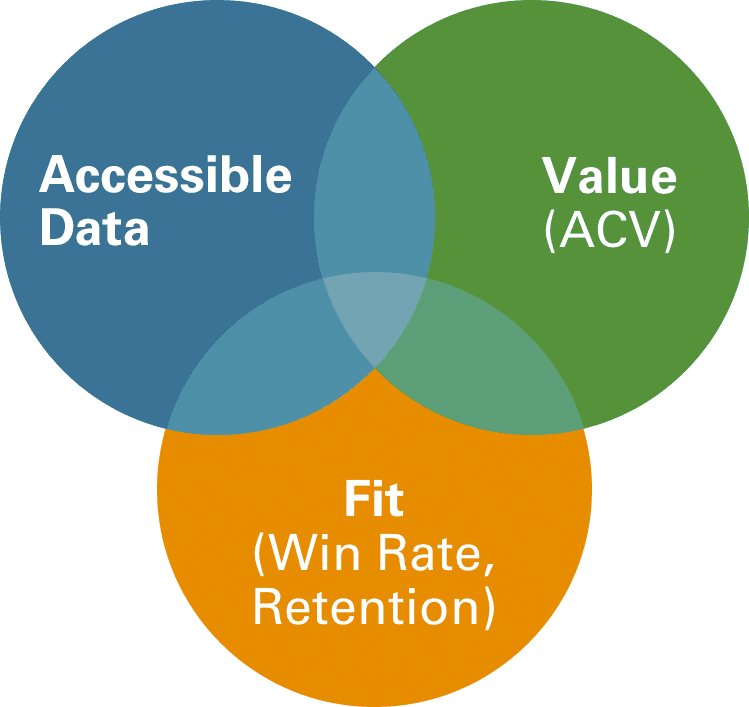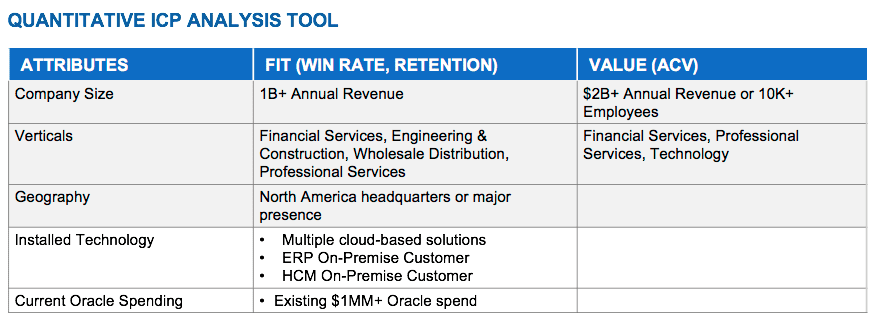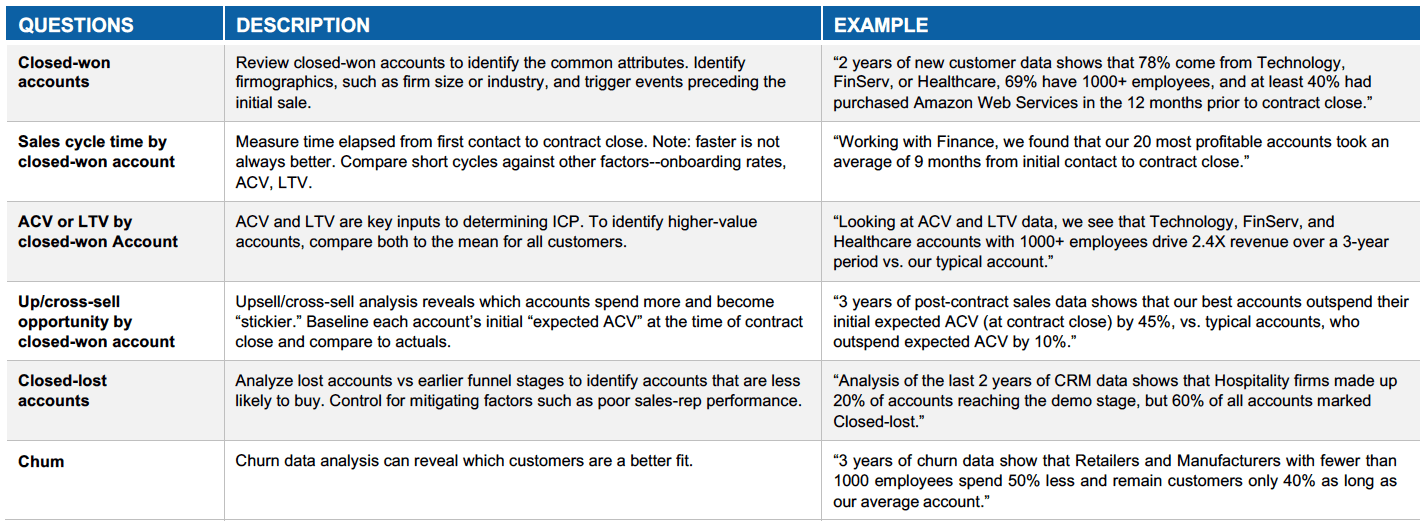The account-based program is focused exclusively on an organizationally agreed-upon ideal customer vs. a traditional program with a widely defined target market that leaves account selection to the discretion of each function.
The Ideal Customer Profile (ICP) identifies the firmographic and environmental attributes of accounts expected to become a company’s most valuable customers. The ICP is the essential building block of each account-based program. It’s the base upon which we create, segment, tier, and rotate a target account list.

QUICK START PROCESS
| STEP | DESCRIPTION | DELIVERABLE | RESOURCES |
|---|---|---|---|
| 1. | Collect quantitative data | List of quantitative attributes of ideal customers | Quantitative ICP Analysis Tool |
| 2. | Collect qualitative input | List of qualitative attributes of ideal customers | Qualitative ICP Workshop |
| 3. | Create list of attributes for consideration | Consolidated list of potential attributes and data sources | Tool: ICP Attributes Worksheet |
| 4. | Define the ICP | Meeting with key stakeholders ending in agreement on ICP definition | Blending Qualitative and Quantitative ICP Inputs |
| 5. | Publish the ICP definition | ICP is documented and accessible to all relevant parties | Example ICP |
ICP DEVELOPMENT PROCESS
The ICP is developed using a combination of qualitative and quantitative analysis. The result of this analysis is combined and refined to create an ICP that has organization-wide acceptance and that facilitates development of a useful target account list.


COLLECTING QUANTITATIVE DATA
Quantitative data comes from two primary sources: The Oracle Advanced Analytics Team and analysis of high-value customers. This data will be compared to qualitative data to determine the ICP later in the process.
The quantitative data process is as follows:
- Gather two primary data sets:
- Attributes from highest fit accounts – the Oracle Advanced Analytics Team will provide a list of the attributes that are most predictive of opportunities that will close.
- Attributes from highest value accounts – Gather the attributes of the highest value accounts (based on deal size or ACV) and identify attributes of the highest value accounts.
-
Combine the data – (See tool below). Insert identified attributes in the attributes column and then provide the data insights in the respective columns.
-
This data will be used later in the ICP creation process.
COLLECTING QUALITATIVE DATA
Alignment around the ICP starts with an understanding of the characteristics that identify best-fit, highest-value accounts. Oracle recommends meetings with, at a minimum, sales, sales development, and product stakeholders to capture this information. If possible, add input from customer success, marketing, finance, and sales engineering.
The objective is to get to a final list of ICP attributes that reflects both strong data analytics as well as the real-life perspective of those cross-functional stakeholders most familiar with the customers, what’s worked in past, and present selling efforts with those customers. Qualitative analysis can be gathered in a live workshop with key stakeholders. ICPs that drive the most pipeline and revenue include a blend of qualitative input and quantitative data. Identifying usable attributes during qualitative workshops requires deep questioning. For attributes to be usable for the ICP, they should ultimately link back to a manual or automated data source that can surface those attributes prior to marketing and sales engagement.
You can use a sample questionnaire like the one below for the qualitative data gathering process:
| QUESTIONS | DESCRIPTION | EXAMPLE |
|---|---|---|
| How would you describe our ideal customer (account)? | Open-ended question to learn how respondents instinctively answer. (Request real account examples in their answers.) | “Companies with more than 20 sales reps that have implemented CRM in the last year” “Annual contract value of $300K+ with products at 40%+ gross margins." |
| What attributes make for an ideal account? | Firmographic information: number of employees, size, revenue, vertical, etc. | “Manufacturing organizations with 1000+ employees, $100M+ in revenue, located in the United States.” |
| What are their key objectives? | Simple description of the ideal customer’s business motivations. | “They have to protect critical customer data” or “They have a global customer base.” |
| What is the infrastructure or operating environment of ideal customers (accounts)? | Infrastructure may include technology, processes, and organizational structure. | “UNIX-based servers,” “multiple remote locations,” “Kanban supply chain" |
| What are the key buying triggers that drive these accounts to take action? | Key events that motivate accounts to drive internal change. | “Overseas expansion,” “recently increased hiring,” “acquisitions,” funding, etc. |
| What are the main reasons accounts don’t buy from us? | Some sales road blocks might be addressed via the ICP. | “Status Quo” or “No pain.” |
| What constitutes an account we absolutely can't sell to? Why? | Open-ended question to identify unworkable accounts and non-opportunities. | “If they bought XX technology in the last 12 months, they will not buy from us." |
QUALITATIVE ICP ANALYSIS CHECKLIST TOOL
QUALITATIVE ICP WORKSHOP
The objective of the workshop and analysis is to get to a final list of ICP attributes that reflects both strong data analytics as well as the real-life perspective of those cross-functional stakeholders most familiar with the customers, what’s worked in past, and present selling efforts with those customers.
Qualitative analysis should be gathered in a live workshop with key stakeholders. ICPs that drive the most pipeline and revenue include a blend of qualitative input and quantitative data. Identifying usable attributes during qualitative workshops requires deep questioning. For attributes to be usable for the ICP, they should ultimately link back to a manual or automated data source that can surface those attributes prior to marketing and sales engagement.
| QUALITATIVE WORKSHOP AGENDA |
|---|
| Purpose: Define the key attributes of an ideal customer |
AGENDA
|
| Outcome: a list of agreed-upon attributes |
Sufficient preparation and time for discussion is key to developing the most effective ICP.
-
Prep stakeholders - Before the meeting send the agenda pointing specifically to the four topics that will be discussed. Ask them to prepare their thoughts for the meeting.
-
Hold the Qualitative ICP Workshop – (see agenda template above) Bring stakeholders together and using a whiteboard or a projected document, document the proposed attributes from the conversation. Drive the interactive conversation by showing them the quantitative ICP to give them something around which to respond. This will accelerate ideas and input.
-
Develop a list of qualitative attributes – This list should be created at the end of the workshop meeting. It will then be used in the ICP creation process.
BLENDING QUALITATIVE AND QUANTITATIVE INPUTS
Qualitative and quantitative inputs will not completely align. Compromise is a must, because the account-based program fails without agreement on the ICP.

After completing data collection, the organization must come together in meetings to agree on the definition. The formation of the ICP definition is an intersection of:
- Fit—Data points such as win rate, retention, etc.
- Value—The highest potential value (ACV, LTV)
- Accessible data points—data that can be identified without conversation
ICP CREATION WORKSHOP
Use a workshop setting to facilitate development of the ICP and agreement among stakeholders.
- Start ICP Creation Workshop – (see ICP Creation Workshop Agenda below) A meeting with all relevant stakeholders is required for deciding on the ICP. The goal of the meeting is to agree on the ICP Definition.
| ICP CREATION WORKSHOP AGENDA |
|---|
| Purpose: agree on ICP attributes and define the ICP |
AGENDA
|
| Outcome: publishable, signed ICP definition |
-
Using a whiteboard or a projected document, discuss the proposed attributes from the combined analysis (see prior step). Where is their agreement? Where is their high value?
-
Create the ICP by starting with characteristics that are aligned across the qualitative and quantitative inputs. Further refine with exclusion characteristics.
-
Agree on ICP Definition and publish – (see ICP Definition Tool). The ICP definition should be documented, agreed-upon (signing the document is recommended), and published to the entire organization.
| BLEND Qualitative and Quantitative |
Identify key areas of:
|
| DISTILL To the most valuable data points |
Distill to data that is
|
| TUNE Data into ICP Definition |
Start by drafting the ICP in the following order:
|
PUBLISH THE ICP
The ultimate goal of the ICP process is to agree on and publish the ICP Definition. An example ICP is provided below. The ICP should be made of descriptive, accessible account data. The ICP is broken up into three potential sections – firmographic (publicly available account details), environmental (especially tech stack but also regulatory requirements), and behavioral (the ongoing activities of the account such as advertising activity or growth through M&A). It is recommended to have stakeholders sign the ICP definition but ultimately, the most important factor is to get official acknowledgement that there is consensus on the ICP definition.
READINESS ASSESSMENT
| COMPONENT | EVALUATION CRITERIA | |
|---|---|---|
| 1. | Accessible data points | Is the ICP based on criteria that can be sourced for accounts, in order to develop the target account list? |
| 2. | The ICP narrows the market focus | Do the ICP characteristics exclude at least 70% of the market (they may exclude far more)? |
| 3. | The ICP isn’t aspirational | Does data validate the likelihood to win accounts that meet the ICP criteria? |
Send your Account-Based questions to kelvin.gee@oracle.com


